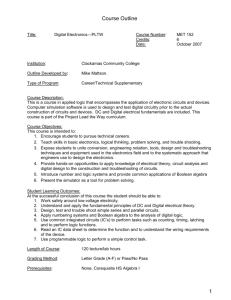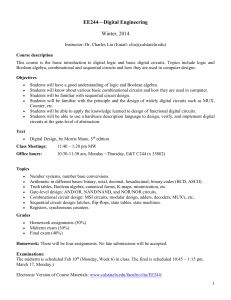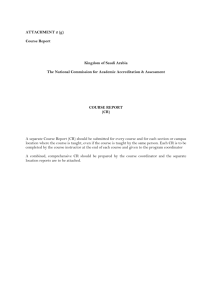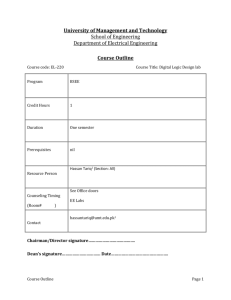Assoc. Prof. Yosry Azzam 2013/2014
advertisement
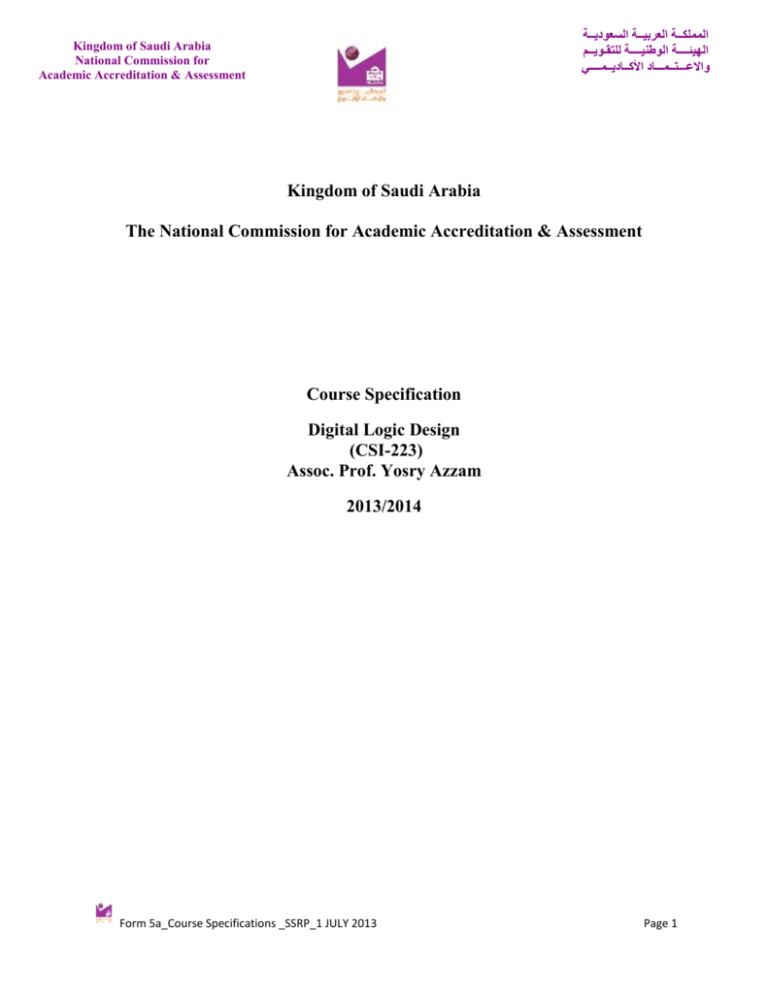
المملكــة العربيــة السعوديــة الهيئــــة الوطنيــــة للتقـويــم واالعـــتــمـــاد األكــاديــمــــي Kingdom of Saudi Arabia National Commission for Academic Accreditation & Assessment Kingdom of Saudi Arabia The National Commission for Academic Accreditation & Assessment Course Specification Digital Logic Design (CSI-223) Assoc. Prof. Yosry Azzam 2013/2014 Form 5a_Course Specifications _SSRP_1 JULY 2013 Page 1 المملكــة العربيــة السعوديــة الهيئــــة الوطنيــــة للتقـويــم واالعـــتــمـــاد األكــاديــمــــي Kingdom of Saudi Arabia National Commission for Academic Accreditation & Assessment Course Specifications Majmaah University Institution: Date of Report: 2013/2014 College/Department: College of Science at Az Zulfi, Department of Computer Science and Information A. Course Identification and General Information 1. Course title and code: Digital Logic Design (CSI-223) 2. Credit hours: 3 credit hours (2 lecture + 2 Lab) 3. Program(s) in which the course is offered. (If general elective available in many programs indicate this rather than list programs) Computer Science and Information Program 4. Name of faculty member responsible for the course Dr. Yosry Azzam 5. Level/year at which this course is offered: 4th level – 2013/2014 6. Pre-requisites for this course (if any): General Physics (PHYS 217) 7. Co-requisites for this course (if any): None 8. Location if not on main campus College of Science at Az Zulfi 9. Mode of Instruction (mark all that apply) a. Traditional classroom √ What percentage? 80% b. Blended (traditional and online) √ What percentage? 10% c. e-learning What percentage? d. Correspondence What percentage? f. Other √ What percentage? 10% Comments: One-tenth of the course instruction is dedicated to students’ self learning where they are asked to read the course book, solve problems in their homes, and do experimental work using some dedicated SW programs that simulate the real HW kits. Form 5a_Course Specifications _SSRP_1 JULY 2013 Page 2 Kingdom of Saudi Arabia National Commission for Academic Accreditation & Assessment المملكــة العربيــة السعوديــة الهيئــــة الوطنيــــة للتقـويــم واالعـــتــمـــاد األكــاديــمــــي B Objectives 1. What is the main purpose for this course? The course provides students with basic knowledge in: Binary Numbers, Octal and Hexadecimal Numbers, Number Base Conversions, Complements, Signed Binary Numbers, Binary Codes; Boolean Algebra and Logic Gates, Basic Definitions, Axiomatic Definition of Boolean Algebra, Basic Theorems and Properties of Boolean Algebra, Boolean Functions, Canonical and Standard Forms. Digital Logic Gates, Integrated Circuits, Transistor equivalent of Digital Logic Gates; Gate-Level Minimization, The Map Method, Four-Variable Map, Five-Variable Map, Product of Sums Simplification, Don't-Care Conditions, NAND and NOR Implementation, Exclusive-OR Function; Combinational Logic, Combinational Circuits, Analysis Procedure, Design Procedure, Binary AdderSubtractor, Decimal Adder, Binary Multiplier, Magnitude Comparator, Decoders, Encoders, Multiplexers; Sequential circuits: Latches and Flip flops, Sequential circuits analysis and design, Finite state machines, Registers and Counters. As so, the purpose of this course is to: 12345- Study number systems and codes and their application to digital systems. Apply Boolean algebra to the design and characterization of digital circuits. Explain the mathematical characteristics of logical gates. Apply truth tables, Boolean algebra, Karnaugh maps. Implement design equations and procedures to design combinational systems consisting of gates. 6- Apply alternative techniques to simplify the design process. 7- Utilize decoders and multiplexers in the design of logic. 8- Design and describe the operation of basic memory elements. 9- Analyze the behavior of sequential synchronous circuits. 10- Use registers and counters in the sequential circuits. 2. Briefly describe any plans for developing and improving the course that are being implemented. (e.g. increased use of IT or web based reference material, changes in content as a result of new research in the field) 1. Using group discussion through the internet with course attending students. 2. Updating the materials of the course to cover the new topics of the field. 3. Increasing the ability of the students to implement and do experimental work using some dedicated SW programs that simulate the real HW kits. Form 5a_Course Specifications _SSRP_1 JULY 2013 Page 3 المملكــة العربيــة السعوديــة الهيئــــة الوطنيــــة للتقـويــم واالعـــتــمـــاد األكــاديــمــــي Kingdom of Saudi Arabia National Commission for Academic Accreditation & Assessment C. Course Description (Note: General description in the form to be used for the Bulletin or handbook should be attached) 1. Topics to be Covered No of Weeks Contact hours Course Introduction Introduction to digital systems and their applications Binary systems 1 4 2 8 Boolean Algebra and logic gates 3 12 Gate Level Minimization 3 12 Combinational Logic 3 12 Synchronous Sequential Logic 3 12 List of Topics 2. Course components (total contact hours and credits per semester): Lecture Tutorial Laboratory Practical Other: Total Contact Hours 30 - 30 - - 60 Credit 30 - 15 - - 45 4. Additional private study/learning hours expected for students per week. 4 The private self-study of my students is crucial for this course. It includes: reading carefully the topics in the textbook or reference book, solving the exercises that are assigned in each chapter, browsing the websites that concerned with the course, discussing the course topics with the instructor in his office hours, watching the video lectures of other instructors who presented related topics worldwide. The total workload of the student in this course is then: 60 + 4 * 15 = 120 work hours. Form 5a_Course Specifications _SSRP_1 JULY 2013 Page 4 المملكــة العربيــة السعوديــة الهيئــــة الوطنيــــة للتقـويــم واالعـــتــمـــاد األكــاديــمــــي Kingdom of Saudi Arabia National Commission for Academic Accreditation & Assessment 4. Course Learning Outcomes in NQF Domains of Learning and Alignment with Assessment Methods and Teaching Strategy: By the end of this course, students will be able to: 1.0 NQF Learning Domains And Course Learning Outcomes Knowledge 1.1 Gain knowledge and understand of Binary Systems, Boolean Algebra and Logic Gates. 1.2 Understand of Canonical and standard forms, and Gate level minimization. 1.3 Gain knowledge of Combinational Logic, Storage elements, and Sequential synchronous circuits 2.0 Cognitive Skills 2.1 Demonstrate the use of number systems and codes as well as explaining the mathematical characteristics of logical gates. Apply truth tables, Boolean algebra, Karnaugh maps, and other methods to the design and characterization of digital circuits as well as to obtain design equations. Implement design equations and procedures to design combinational systems consisting of gates. Apply alternative techniques to simplify the design process yielding innovative designs. Utilize decoders and multiplexers in the design of logic gates and descriptions of the operation of basic memory elements. Analyze and design synchronous sequential circuits as well as the use of registers and counters in these circuits. 2.2 2.3 2.4 2.5 2.6 3.0 Course Teaching Strategies Course Assessment Methods Lectures Lab demonstrations Case studies Individual presentations Written Exam Homework assignments Lab assignments Class Activities Quizzes Lectures Lab demonstrations Case studies Individual presentations Brainstorming Written Exam Homework assignments Lab assignments Class Activities Quizzes Small group discussion Whole group discussion Brainstorming Presentation Written Exam Homework assignments Lab assignments Class Activities Quizzes Interpersonal Skills & Responsibility 3.1 Submit a group final project at the end of the semester that involves the implementation of design theory, and the use of a simulation package to develop a complex digital circuit. 3.2 Each student should submit a report and give a presentation of his work. Form 5a_Course Specifications _SSRP_1 JULY 2013 Page 5 المملكــة العربيــة السعوديــة الهيئــــة الوطنيــــة للتقـويــم واالعـــتــمـــاد األكــاديــمــــي Kingdom of Saudi Arabia National Commission for Academic Accreditation & Assessment 4.0 Communication, Information Technology, Numerical 4.1 4.2 Participate and discuss during the lectures Small group discussion Perform research and encourage performing Whole group team work activity. discussion Prepare reports and improve communication Brainstorming Presentation skills. Use the internet to search for related topics Psychomotor 4.3 4.4 5.0 Written Exam Homework assignments Lab assignments Class Activities Quizzes 5.1 5.2 5. Schedule of Assessment Tasks for Students During the Semester Assessment task (e.g. essay, test, group project, examination, speech, oral presentation, etc.) 1 First written mid-term exam Week Due 6 Proportion of Total Assessment 15% 2 Second written mid-term exam 12 15% 3 Presentation, class activities, and group discussion Every week 5% 4 Homework assignments 5% 5 Final Lab Exam After Every chapter 15 6 Final written exam 16 40% Total Form 5a_Course Specifications _SSRP_1 JULY 2013 20% 100% Page 6 Kingdom of Saudi Arabia National Commission for Academic Accreditation & Assessment المملكــة العربيــة السعوديــة الهيئــــة الوطنيــــة للتقـويــم واالعـــتــمـــاد األكــاديــمــــي D. Student Academic Counseling and Support 1. Arrangements for availability of faculty and teaching staff for individual student consultations and academic advice. (include amount of time teaching staff are expected to be available each week) Office hours: Sun – Wed: 12 PM - 2:00 PM Office call: Sun – Wed: 12 PM - 2:00 PM Email: Y.Azzam@mu.edu.sa E. Learning Resources 1. List Required Textbooks M. Morris Mano , Michael D. Ciletti , Digital Design: With an Introduction to the Verilog HDL, 5th Edition, Prentice-Hall, 2012 2. List Essential References Materials (Journals, Reports, etc.) 1- M. Morris Mano and Charles R. Kime, Logic and Computer Design Fundamentals, 4th Edition, Prentice-Hall, 2008 2- C. H. Roth, Fundamentals of Logic Design, Thomson Brooks / Cole, 2004 3. List Recommended Textbooks and Reference Material (Journals, Reports, etc) 4. List Electronic Materials (eg. Web Sites, Social Media, Blackboard, etc.) 5. Other learning material such as computer-based programs/CD, professional standards or regulations and software. Logic Gate Simulator. F. Facilities Required Indicate requirements for the course including size of classrooms and laboratories (i.e. number of seats in classrooms and laboratories, extent of computer access etc.) 1. Accommodation (Classrooms, laboratories, demonstration rooms/labs, etc.) Classroom and Lab, as those that are available at college of science at Az Zulfi. 2. Computing resources (AV, data show, Smart Board, software, etc.) Smart Board Form 5a_Course Specifications _SSRP_1 JULY 2013 Page 7 المملكــة العربيــة السعوديــة الهيئــــة الوطنيــــة للتقـويــم واالعـــتــمـــاد األكــاديــمــــي Kingdom of Saudi Arabia National Commission for Academic Accreditation & Assessment 3. Other resources (specify, e.g. if specific laboratory equipment is required, list requirements or attach list) Hardwired logic gate kits. G Course Evaluation and Improvement Processes 1 Strategies for Obtaining Student Feedback on Effectiveness of Teaching Questionnaires (course evaluation) achieved by the students and it is electronically organized by the faculty member on his personal site. Student-faculty management meetings. 2 Other Strategies for Evaluation of Teaching by the Program/Department Instructor Discussion within the staff members teaching the course Departmental internal review of the course. 3 Processes for Improvement of Teaching Periodical departmental revision of methods of teaching. Monitoring of teaching activates by senior faculty members. Training course. 5 Describe the planning arrangements for periodically reviewing course effectiveness and planning for improvement. Course evaluation Exam evaluation Improvement plan Faculty or Teaching Staff: Assoc. Prof. Yosry A. Azzam Signature: _______________________________ Date Report Completed: 2013/2014 Received by: _____________________________ Dean/Department Head Signature: _______________________________ Date: _______________ Form 5a_Course Specifications _SSRP_1 JULY 2013 Page 8
